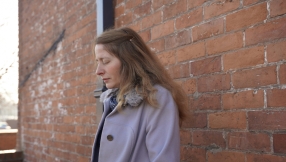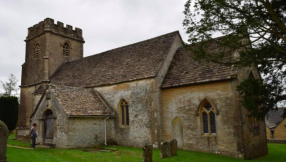
The writer of the Letter to the Hebrews reminds Christians that they are surrounded by a great "cloud of witnesses." (NRSV) That "cloud" has continued to grow in size since then. In this monthly column we will be thinking about some of the people and events, over the past 2000 years, that have helped make up this "cloud." People and events that have helped build the community of the Christian church as it exists today.
The banning of Christmas
Christmas gives Christians an extraordinary opportunity to celebrate and talk about the birth of Jesus. From carols playing in supermarkets (as well as a mixed bag of "Christmas songs," it must be admitted), to Nativity Plays in primary schools (they still happen in many schools), the Baby of Bethlehem is apparent in many areas of the seasonal festivities. And most people still wish each other "Happy Christmas" or send Christmas cards (even if nativity scenes have to compete with cheerful robins and idealised rural winterscapes in these).
This occurs despite the occasional intrusion of attempted secularised inclusivity, embodied in such artificial creations as "Winterval" or "Happy Holidays." For most people, Christ is at the beginning of Christmas even if simply as a matter of grammar. The opportunity to take this further is embedded in the season, despite all that acts to the contrary.
However, there are Christians who are uncomfortable about Christmas. They are often concerned at commercialisation and secularisation overshadowing the true spiritual meaning. In contrast to this are humanists and secularists who would like to see all its spiritual character side-lined and sometimes claim to act as voices for non-Christian religions who frequently protest that – actually – they have no problem with the celebration, despite what is sometimes said on their behalf!
In short, the "season of goodwill" can be the subject of some fierce debates and disagreements. This is not the first time that Christmas has faced challenges.
A "world turned upside down"
The biggest direct challenge that the celebration of Christmas has ever faced in Britain occurred in the 1640s and 1650s. And it occurred at the hands of believers who passionately believed that their conflict with it represented the will of God in purifying the church and nation.
This took place during one of the most radicalised periods of British history – both in terms of politics and faith. We might flinch at drawing comparisons with the rule of the Taliban in Afghanistan, but I would argue that the parallels are there. And in Ireland, the vast numbers of victims of warfare and religious persecution might have felt there was something of ISIS and Syria in the application of what many at the time described as "godly rule."
It was a most extraordinary time in the history of the British Isles and it accompanied a war in which war-related deaths reached at least 3.6% of the population, compared with a UK First World War figure of around 2.6%. Some other (higher) estimates put the casualty figures of the 17th-century civil wars as high as 11.5%, compared to 3.04% for the First World War and 0.94% for the Second World War.
These percentages do not take into account the catastrophic casualty figures for Ireland. But the key point is that even the lowest estimates reveal the enormity of the conflict. The suffering was immense and it accompanied massive social upheaval.
In 1647 a woodcut print appeared on the cover of a pamphlet. On it, a man – at centre – wears gloves on his feet and spurred-boots on his hands; his bottom half is clothed in a jacket while his arms wear trousers; a fish flies above his head; a mouse chases a cat and a hare a hound; a church and a candle are upside down in the sky; while another man pushes a wheelbarrow with his feet and an upright horse drives a cart. The title above the illustration reads: "The World turn'd upside down: or A briefe description of the ridiculous Fashions of these dustracted Times."
Its title echoed a phrase found in the 1611 Authorized – or King James – Version of the Bible, referring to turmoil in the Greek city of Thessalonica caused by opposition to the preaching of the Apostle Paul, in which the apostle was charged that, "These that have turned the world upside down are come hither also." The Geneva Bible – at the time more popular among the godly – put it less memorably as: "These are they which have subverted the state of the world."
The choice of the more memorable phrase for the 1647 publication suggests that it was the 1611 version of the Bible that had inspired the title of the pamphlet. That pamphlet, in its turn, inspired Christopher Hill's 1972 study of the most radical and revolutionary movements of the 1640s: The World Turned Upside Down.
By the middle of the 1640s, the increasingly heated clashes between the monarch (Charles I) and his opponents, spiralled down into the British Civil Wars, and seemed to have turned the established order on its head.
To cut a long story short, the 1640s were the decade that saw the disintegration of the status quo in British state, politics and religion and the ascendancy of those who frequently referred to themselves as "the godly." Charles I and his supporters (including Anglicans who espoused more formal and traditional church worship and community) eventually came to blows with those in Parliament (often termed "Puritans," "the godly" and "the saints") who wished to both constrain royal power (which they thought a tyranny) and purify the church and society of what they considered vestiges of Catholicism, and of ungodly superstitions and behaviour.
At its simplest, they envisaged a church community centred around Bible-preaching rather than elaborate ceremony and they actively campaigned for a society that was brought into line with strict morality that they felt embodied biblical principles. Most also wanted to purge from religious celebration and activities anything that was not specifically referred to in the Bible. Almost all of them were Calvinists, whose model of an ideal Christian community looked for its inspiration to the kind of community that Calvin had sought to establish at Geneva in the previous century.
Charles eventually left London to rally royalist support and, in August 1642, he set up his royal standard at Nottingham. At the same time, Parliament took control over the Trained Bands of as many of the county militia regiments as it could. The country slid into civil war. Now at last it might be decided who was really king. To Charles it was himself under God. Over the next six and a half years an increasingly influential number within the godly would finally come to the decision that it would be God and his representatives among the saints (as they discerned his will).
In this febrile atmosphere the most radical versions of Christian politics flourished and were both debated and (some at least) implemented. And in this atmosphere, Christmas was in the firing line.
Christmas becomes the victim of "the godly"
Cromwell is often described as the man who banned Christmas. The matter, though, is more complex. For, while the celebration of Christmas continued to be proscribed following his accession as Lord Protector in 1653, this had certainly not started under Cromwell. The Scottish Kirk attempted to abolish Christmas festivities in the 1560s. James VI and I restored the feast there in 1617, but it was banned in Scotland again in 1640.
So, what was the problem with Christmas for the godly? Firstly, while all believed in the Virgin Birth of Jesus, no later festivity celebrating it was found in the New Testament; secondly, it was accused of being a popish celebration (grounded as it was in centuries of pre-Reformation customs); thirdly, it was associated with festivities that were regarded as worldly.
From 1641 this hard-line Puritan attitude was also evident in England. In 1645 the Royalist, John Taylor at Oxford, could lament in his The Complaint of Christmas, how traditional Christmas celebrations "are now extinct and put out of use... as if they had never been," and that "thus are the merry lords of misrule suppressed by the mad lords of bad rule at Westminster."
Christmas had fallen foul of a Puritan-led campaign against both its perceived over-exuberant activities and its association with (they claimed) Catholic traditions. As early as 1643 Puritan-inclined tradespeople opened their shops as normal on Christmas day and MPs sat in Parliament. Churches were kept shut.
In 1644 what had once been a feast day was declared a fast - part of Parliament's monthly day of prayer and fasting aimed at bringing about an end to the war. At the same time, a specific ordinance was passed to formalise this decision and to direct that church services were not to be held that day.
In the chaos of the times, and given the late passing of the ordinance, it is likely that a lot of people ignored it. Consequently, in January 1645, Parliament issued its Directory for the Public Worship of God, an alternative to the Book of Common Prayer, with no reference to Christmas as a church event. It took the same approach to Easter services too. Thus, by December 1645, Christmas officially ceased to exist in Parliamentary areas of the country.
The blanket ban came in June 1647. It was then that Parliament passed an ordinance banning Christmas, Easter, and Whitsun festivities, services and celebrations. This included the banning of festivities in the home. Decorative use of holly, ivy and other evergreens was outlawed. Parliament of the godly was determined to impose its version of faith in both the public and the private sphere, and there were fines for non-compliance.
There is evidence that this was very unpopular and there were even pro-Christmas riots in East Anglia, in London, and in Canterbury in protest. At Canterbury the traditional Christmas football game went ahead and, in the end, force had to be used to restore "godly order."
With Parliamentary victory in the civil wars, the – temporary – fate of Christmas was sealed. In 1652 laws reinforced the Christmas ban, imposing fines for staging or attending Christmas services, and shops were ordered to remain open on Christmas Day. However, in 1652, John Taylor's The Vindication of Christmas claimed that Devon farmers still celebrated it, which shows that, away from the hotspots of Puritanism, there was resistance to the anti-Christmas legislation.
With regard to Oliver Cromwell, he cannot be held responsible for the anti-Christmas campaign in the 1640s, but he certainly supported it, holding government meetings on 25 December. In 1655, there was an attempt to enforce the ban more rigorously in some parts of the country under military rule; often termed the "Rule of the Major Generals."
However, resistance was increasing. In 1656 Parliament complained that many people ignored the ban. Even in London – the seat of Parliament – a number of shops resolutely remained shut and some Puritan MPs complained that they were kept awake by the sound of Christmas parties.
It was not until the Restoration of the monarchy, in 1660, that Christmas was restored. And there is plenty of evidence to show its return was greeted with widespread joy. So, Happy Christmas! Make the most of the opportunity to talk about Jesus!
Martyn Whittock is an evangelical historian and a Licensed Lay Minister in the Church of England. The author, or co-author, of fifty-five books, his most recent books include: Trump and the Puritans (2020), The Secret History of Soviet Russia's Police State (2020), Daughters of Eve (2021), Jesus the Unauthorized Biography (2021), The End Times, Again? (2021), The Story of the Cross (2021), and Apocalyptic Politics (2022). In addition, he has an interest in the 17th-century Christian radicals and their continuing impact on the modern world, the subject of his books When God was King: Rebels & Radicals of the Civil War & Mayflower Generation (2018) and Mayflower Lives (2019). He is a big fan of Christmas.













